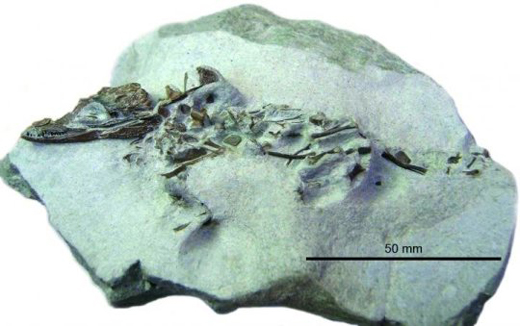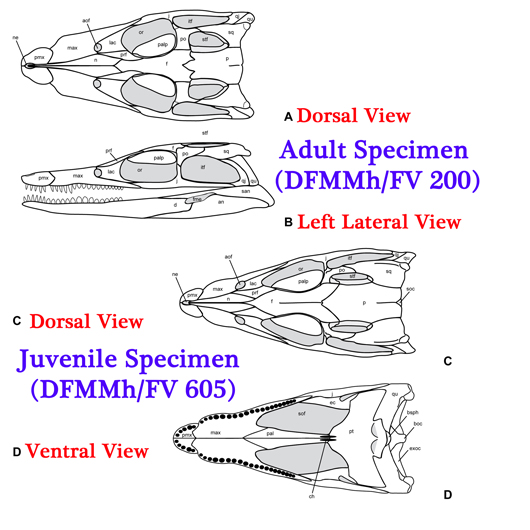Not All Mesozoic Crocodiles Were Giants According to New Study
Knoetschkesuchus – Living on an Island
Last month, scientists published in the on-line academic journal “PLOS ONE” a paper that provided details of the discovery of a new species of Late Jurassic terrestrial crocodile, but this animal was no ground-shaking giant, like most of its kind (atoposaurids), it probably had a maximum length of under a metre and it would have weighed a couple of kilogrammes or so.
Lead author of the research paper, Daniela Schwarz (Leibniz Institute for Evolutionary and Biodiversity Research, Germany), in collaboration with colleagues, re-examined fossils including skull material (an adult and a juvenile specimen), that had previously been assigned to the atoposaurid Theriosuchus – a genus of crocodile-like reptile that is known from a large number of fossils dating from the Late Jurassic and into the Early Cretaceous from places as far apart as Thailand and southern England. However, when the beautifully preserved fossils were studied using CT scans and three-dimensional images of the fossil material created, a number of autapomorphies were identified to allow the erection of a new genus.
A View of the Larger Specimen of Knoetschkesuchus langenbergensis
Picture credit: PLOS ONE
Knoetschkesuchus langenbergensis
The little crocodile has been named Knoetschkesuchus langenbergensis, the fossils come from the famous Langenberg Quarry, located near the town of Goslar, Lower Saxony, northern Germany. The limestones and marls that form the quarry site, were laid down in shallow inlets associated with an island archipelago. The Knoetschkesuchus material comes from Bed 83, the same location as the fossils of the dwarf sauropod Europasaurus (E. holgeri).
For replicas and models of ancient crocodilians and other prehistoric animals: Mojo Fun Prehistoric and Extinct Models.
Lots of Terrestrial Crocodiles in the Mesozoic
Knoetschkesuchus langenbergensis fossil material has been dated to the Upper Kimmeridgian stage of the Jurassic, approximately 154 million years ago, like most members of the Atoposauridae it had large eyes and it may have been a fast runner. The researchers conclude that the Langenberg Quarry fossils represent a new species because of unique features of the skull, such as openings in the jaw bone and in front of the eye, as well as the shape and placement of the animal’s tiny teeth.
The teeth are heterodont in nature (different shapes), at the tip of the snout they are pointy and needle-like, very typical of a small crocodilian. Towards the back of the jaws they are broader and more rounded, particularly in the lower jaw. It has been suggested that these teeth were adapted for crushing hard-shelled prey, such as snails, which are known from abundant gastropod fossils associated with Bed 83.
Line Drawings Showing Various Views of Both the Adult and Juvenile Skull Specimens
Picture credit: PLOS ONE with additional annotation by Everything Dinosaur
Note
Elements of the adult skull fossil have been drawn based on scaled-up material from the juvenile specimen.
Dr Schwarz commented:
“The study describes a new diminutive crocodile Knoetschkesuchus langenbergensis that lived around 154 Million years ago in north-western Germany. Knoetschkesuchus belongs to the evolutionary lineage that leads to modern crocodiles and preserves for the first time in this group two skulls in 3-D, allowing us detailed anatomical studies via micro-CT images. Our research is part of the Europasaurus-Project which studies the remains of a unique Jurassic island ecosystem in northern Germany.”
A Unique Island Ecosystem
The Langenberg Quarry preserves the remains of a unique Late Jurassic European ecosystem. The islands were relatively small and this led to a divergence between residents of these islands and their ancestors which lived on the larger landmasses to the east. For example, in response to limited food resources and space, the sauropod Europasaurus became a dwarf form.
The atoposaurid crocodiles probably filled a number of ecological niches within the food chain, including that of arboreal predators. These distant ancestors of today’s crocodiles were in turn preyed upon by a variety of theropod dinosaurs, the majority of which are only known from fragmentary teeth. What is quite remarkable, is the diversity of the theropod teeth found in Upper Jurassic deposits of northern Germany. Studies have suggested that representatives of the Tyrannosauroidea, as well as Allosauroidea, Megalosauroidea and probably Ceratosauria roamed this part of the world some 155 to 150 million years ago.
The genus name (Knoetschkesuchus) is a combination of the family name of Nils Knötschke, and suchus (from the Greek meaning crocodile). The genus name honours of Nils Knötschke (Dinosaurier-Freilichtmuseum Münchehagen), who collected, prepared, and curated several important fossil specimens from the Langenberg Quarry.
Visit the Everything Dinosaur website: Everything Dinosaur.



